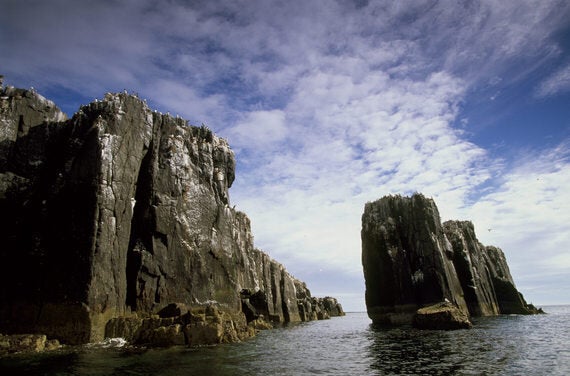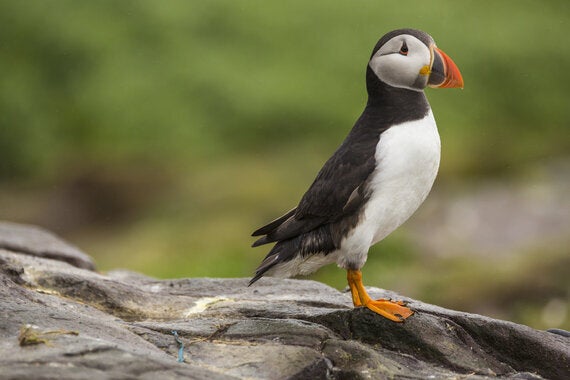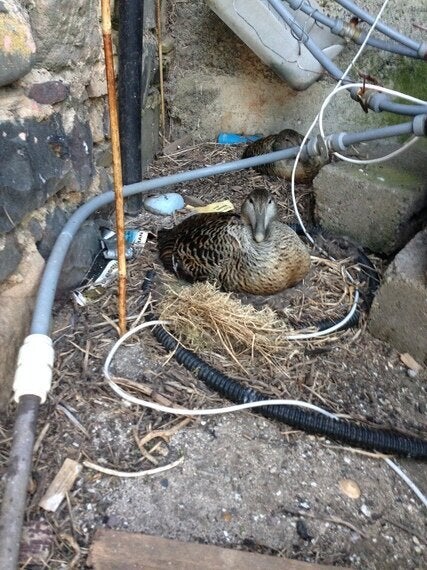In the last few weeks I've moved from windy west Wales to the sunnier, foggier Northumberland Coast and the Farne Islands.
It's hard to describe the feeling you get when you approach the islands for the first time. I was lucky enough to be taken over on a Zodiac boat which is strictly reserved for staff.

It certainly focuses the mind going into the North sea on a tiny inflatable dingy. But the trepidation melts away when you see your first seabird.
In the harbour gulls and eider ducks cry, making their strange 'faux surprise' sounds.
On the open sea, little black dots start to appear on the water.
You might see the occasional black and white puffin or guillemot flapping furiously past. As you float into a sea of these birds, they flap away with a furious clattering sound, as their feet slap the water and their wings pedal furiously.
Overhead, graceful terns can be seen wheeling through the air or heading out to sea.
And then the smell - like ammonia and paint mixed together - from all the guano as the rocks loom into view.
Over the coming weeks we'll be sharing these islands with BBC Springwatch.
From Monday, Iolo Williams will present a daily update from the Farne Islands. Viewers of the popular wildlife show will get to see the very best wildlife the islands have to offer.
The Farnes is home to around 85,000 pairs of seabirds. Here are my top three Farnes birds to watch out for.
1.Puffin
The Farnes' most famous resident. Often pictured with its multi-coloured beak, carrying lovely shining fish to their burrows. They can often be seen peeking out timidly from their burrows. We rarely walk on the areas off the boardwalks. There are so many burrows underground that the ceiling can frequently collapse!

Puffins have a hidden dark side. When they arrive back on the islands in the spring they immediately set about kicking rabbits out of their burrows. Knowing this, we installed cameras in some of the existing burrows. One of our puffins decided to dig around the piece of wood upon which the camera was placed. Using its beak and its tail, and anything it could, they pushed the piece of wood slowly up against the camera. The puffin only appeared satisfied when the entire screen was blocked with the wood.
DID YOU KNOW - Puffins' distinctive red and grey beak becomes duller once the breeding season comes to an end. Their winter plumage is rarely seen, as these birds head out to sea for the winter - only returning to land to breed the following spring.
2.Arctic tern
From mid-May until fledging these angel-like birds will dive-bomb us and peck us in the head as well as poo-ing on us - all in a bid to protect their chicks. There is a finely judged 'hat on' date when all rangers avoid venturing out to prevent undue disturbance and don a hat to move through the colony.

The terns nest everywhere - on paths, boardwalks and anywhere else they can get in. You need to watch your feet, being careful not to step on the tern chicks.
They may look delicate, but these birds fly thousands of miles each year. An Arctic Tern ringed on the Farne Islands in 1982 was spotted in Melbourne, Australia three months later - a distance of over 10,000 miles.
3.Eider duck
A dumpy, chunky bird - and my current favourite on the Farnes. The males look handsome in a classical way, with black green and white feathers like a sports kit. Their soft moaning call shatters the illusion of 'sleekness' they initially appear to project. Being a true sea duck, they mainly eat molluscs and crustaceans, with a specially adapted gut to crush and excrete the shells.
The beautiful pale blue eggs are incubated by the female at all times. These ladies nest wherever they fancy - in doorways, under benches or generators - and just stare at you, confused, if they're disturbed. We count the eider's eggs by gently lifting these genteel birds from their nest. Their docile nature is probably why eider down was so easy to harvest!

One particular female eider has taken against one of our rangers. She will aggressively nip his ankles whenever he passes on the boardwalk. We are in their kingdom after all...
Rumour has it that one-time Farnes resident St Cuthbert was so fond of these birds he put out a conservation edict to protect them. Our volunteer archivist Anne thinks it's more likely he would have felt an affinity for all the wildlife here as part of his Celtic Christian faith. Perhaps the eiders were the only species he didn't eat?
TOP TIP: Watching Springwatch? See if you can spot the Shag's long necks vibrating. These petrol green seabirds use it as a way to regulate their body heat - similar to the way a dog pants.
Watch Springwatch on BBC2 at 8pm, 30 May to 17 June.